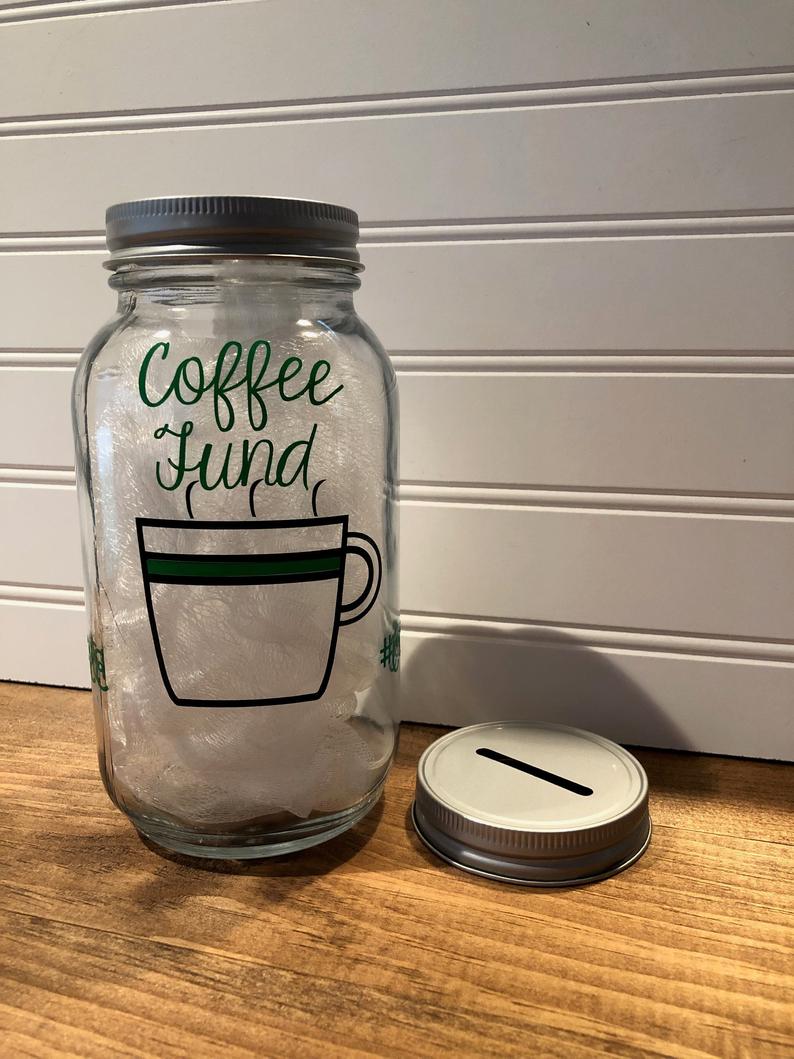
Remember the days when your radio station was open 24/7, and the full staff showed up every day.
So, then imagine the boss thought it would be a cool idea to purchase a steady supply of coffee and make it available to the staff for a nominal fee. And we’re not just talking any random or generic coffee brand. The boss is into quality and insists on gourmet beans that truly make wonderful coffee – many say the best around.
The boss sets up the “honor system” for the coffee fund. When you pour yourself a cup of coffee, you’re asked to donate 50¢.
But here’s the problem. Even though there’s always a fresh supply of great, premium coffee, not everyone who drinks it makes a contribution. In fact, only about 10% actually contribute to the fund. The rest simply drink the coffee every day, and hope others fork over the dough. Some make excuses they don’t have the funds right now. Others contend the coffee should be free to employees. But most people don’t pay for this wonderful coffee service.
Most responsible bosses wouldn’t put up with this for long. A month or two maybe. At the most, a year.
Now imagine this going on for 40 years.
Because that’s how public radio funding actually works – the honor system.
Aside from a small percentage of government funding through the Corporation of Public Broadcasting, most public radio organizations from NPR to your local stations survive on listener contributions, as well as funding from grants, underwriting, and foundations.
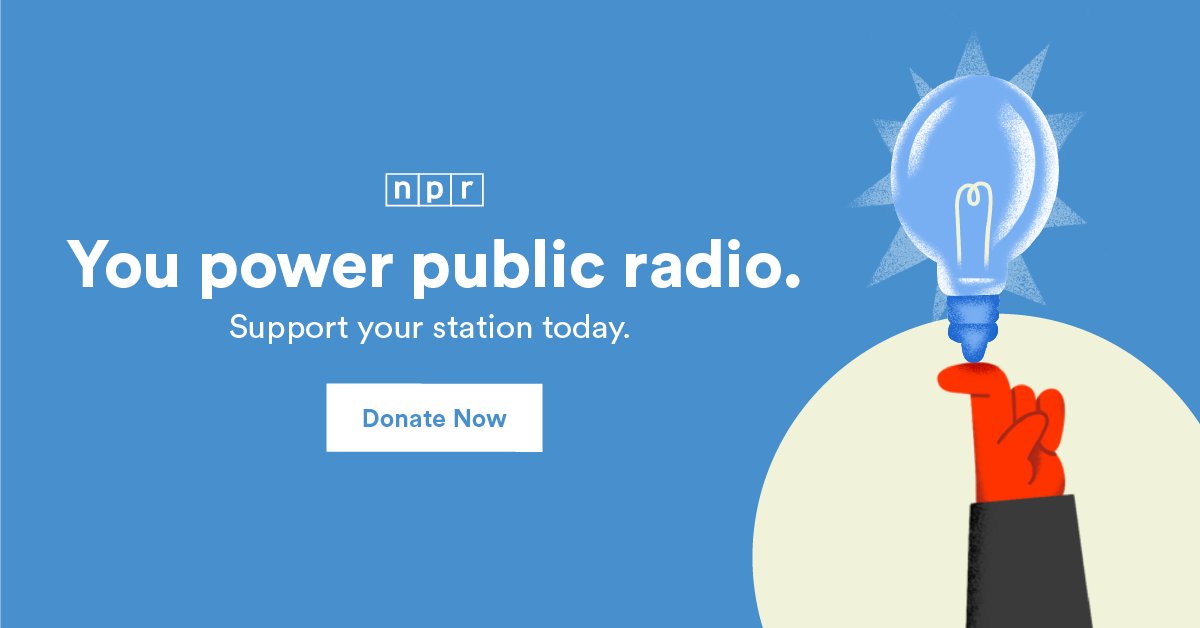 But the bulk of the fees that pay for those wonderful programs – and podcasts – comes from “listeners like you.” Public radio programmers and managers hope that because so many people enjoy their stellar content day in and day out, most will simply pay their fair share.
But the bulk of the fees that pay for those wonderful programs – and podcasts – comes from “listeners like you.” Public radio programmers and managers hope that because so many people enjoy their stellar content day in and day out, most will simply pay their fair share.
Except they don’t. A story in Current (public radio’s main trade publication) in 2017 about alternative donation technology confirmed what most people in public radio know too well:
Only about 10% of public radio listeners end up paying for their fair share. A few years back, a survey by Greater Public found it’s in the 6-12% range.
10%.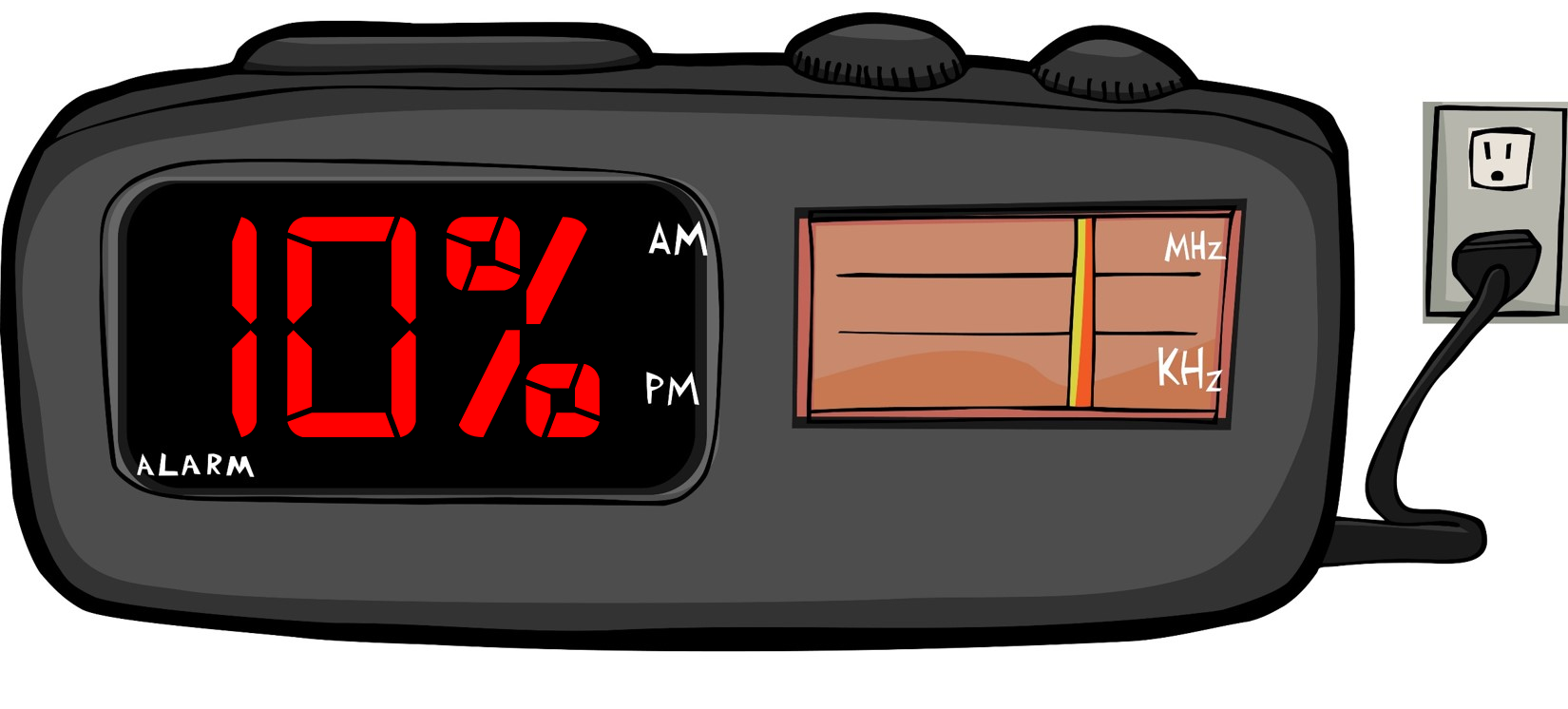
A look at most of the industry trades indicates they are generally consumed by what goes on in commercial radio – a platform that has to make it the old-fashioned way:
Selling spots.
Day after day, there are ongoing stories about the biggest companies – iHeartMedia, Entercom, and a handful of the others.
But there’s a whole lot to be learned from public and Christian radio. They may own the same technical equipment that Z100, KROQ, or WABC uses to broadcast their content to the masses.
But once you get beyond that, their operating distinctions and audience connections are becoming important differentiators.
Take word-of-mouth for example. It is much better among Christian and public radio stations than it is for commercial radio brands.
We recently completed all three of our 2020 Techsurveys, so we can now see just how great the “recommendation” disparity is among the various station groupings.
On the chart below, the red arrow shows the average Net Promoter Score for all of commercial radio – 43. The scores for Christian music and public radio are more than 30 points higher.
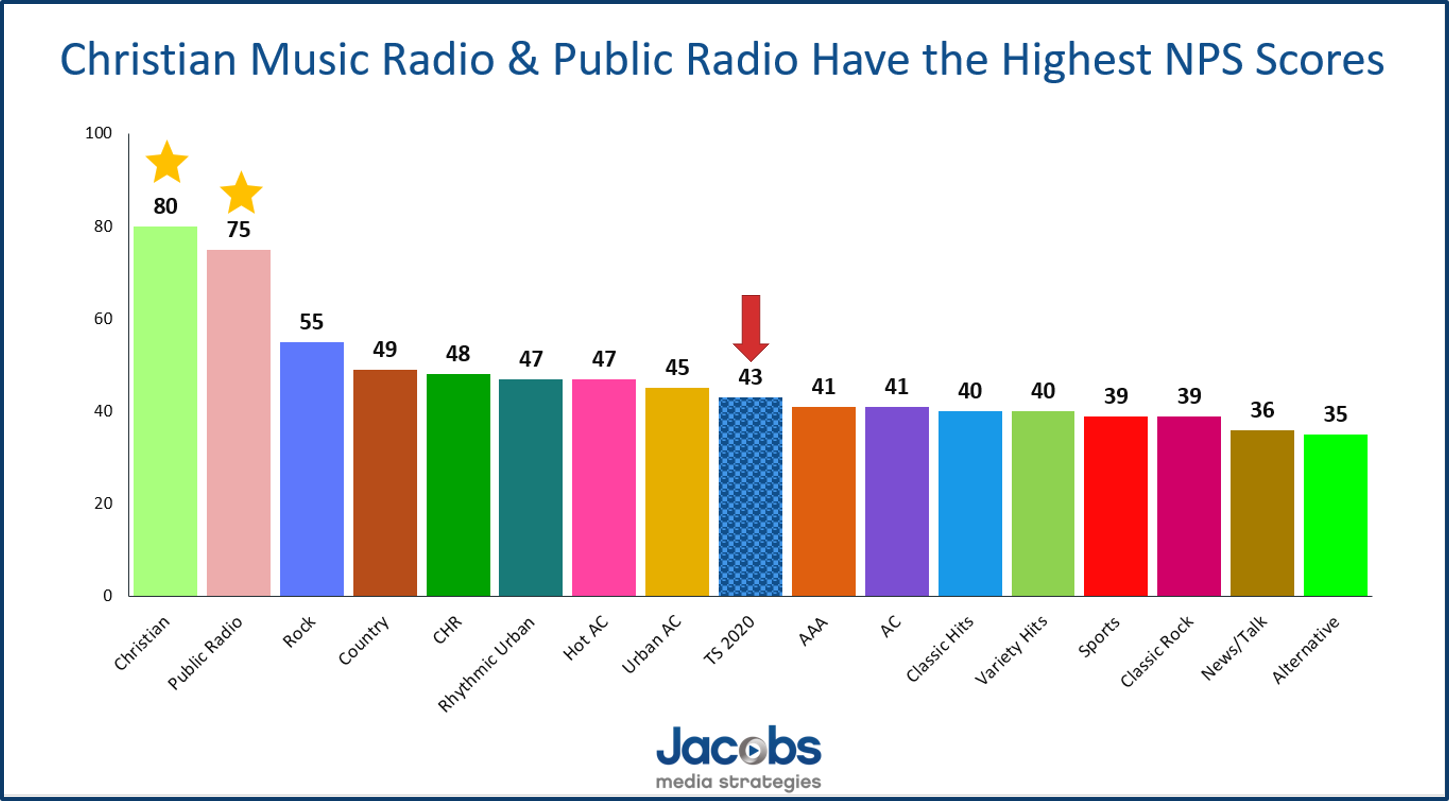
These days, marketing dollars are increasingly non-existent in pretty much all of American radio. Fortunately, social media makes it possible for truly connected and responsive stations and personalities to get the word out – and get it shared by their own audience members.
Public radio, in particular, has other key advantages – many of which it has consistently invested in over the past decade or more.
Apps, streams, news content, automotive, and smart speakers are all examples of this commitment, in time, energy, and financial resources.
One of the shining examples has been podcasting. Many of the most popular podcasts in the marketplace today either originated in the public media universe, or they’ve been heavily influenced by their style and content.
But even with more than one million podcasts now in the marketplace, public radio’s efforts often lead the league. Most data confirms that most months, it’s now a horse race between NPR and iHeartRadio for the top spot.
And for the first time in its history, NPR says it will generate more revenue and profit from its podcasting in 2020 than from conventional radio shows.
While that is impressive, and speaks volumes about where revenue is coming from in 2020, it begs the question whether public radio is deriving as much revenue as it could be from its podcasting and broadcasting efforts.
One thing we do know – public radio fans are paying for somebody’s content.
In PRTS 2020, we examined whether they are subscribing to video and audio streaming content platforms. And the answer is a resounding “yes.”
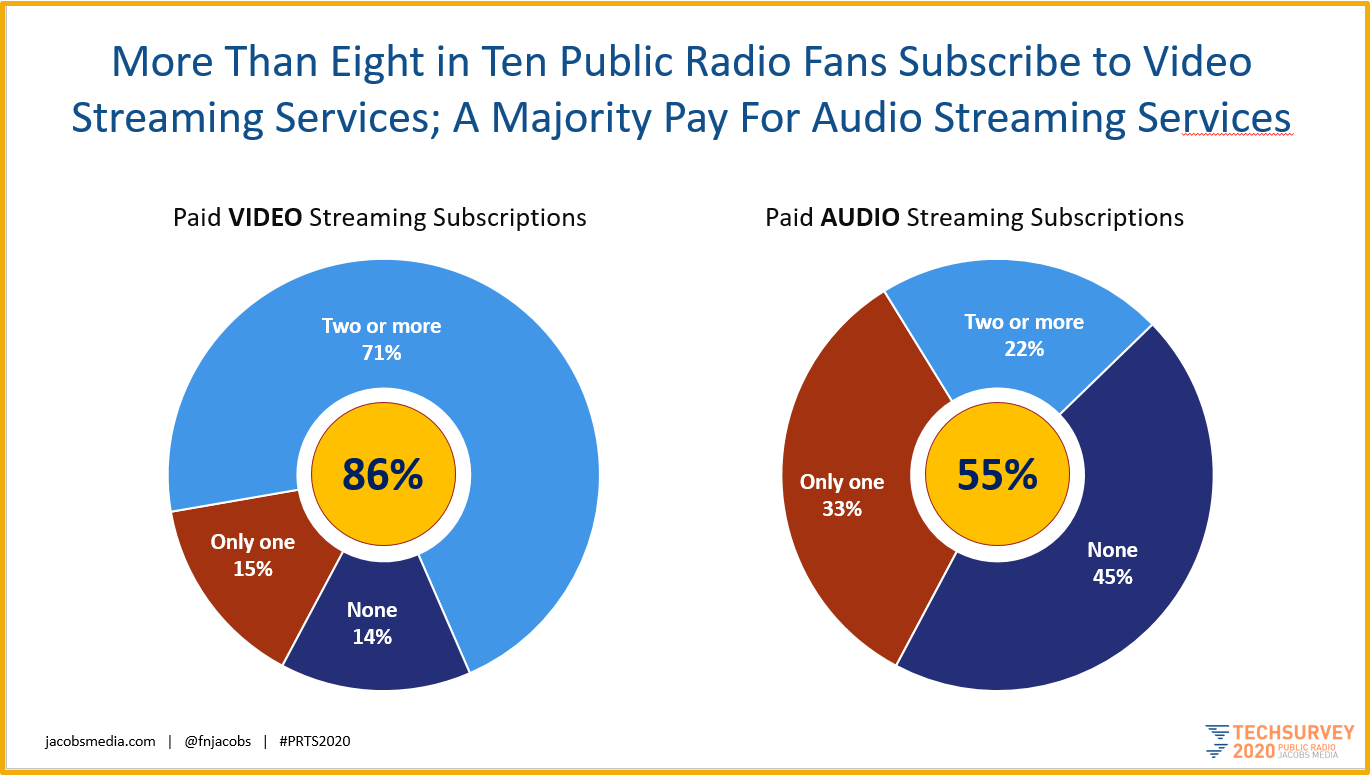
Nearly nine in ten (86%) subscribe to at least one video streaming platform; more than seven in ten are paying for two or more services. While not as common on the audio side of the ledger, a majority says they’re forking over money each month for services like Spotify; more than one-fifth are making payments to two or more audio streaming platforms.
We are living in a subscription culture in 2020. Seemingly every audio and video platform – from Netflix to SiriusXM to Apple to Disney – now has toll booths requiring payment for access. And most people will tell you these services are worth the few bucks a month it costs to keep them profitable – and constantly developing and acquiring new programs and services.
Public radio, on the other hand, operates like a charity. Listeners have been trained to believe they are donating, rather than paying for content services they use and enjoy.
I have moderated several hundred public radio focus groups over the past 2+ decades. Like clockwork, every time “membership” is raised, I hear some of the most avid station or network listeners say, they should give, but they just don’t have the funds. Some even remind me that “everyone has their hands out,” and that it’s difficult to decide between donations to various charities – as well as helping pay for the public radio they listen to every day.
As we move into the fourth quarter in a rapidly eroding economy, it will only get worse. I’m pretty sure Netflix or SiriusXM subscribers aren’t thinking about whether they should continue paying for the entertainment content they consume versus a great cause. They are two very different things.
Except in public radio (and yes, public TV.)
In this environment, we’re seeing tangible signs the system is breaking down. Actually, at only about 10% effectiveness, you might make the claim it’s never really worked well.
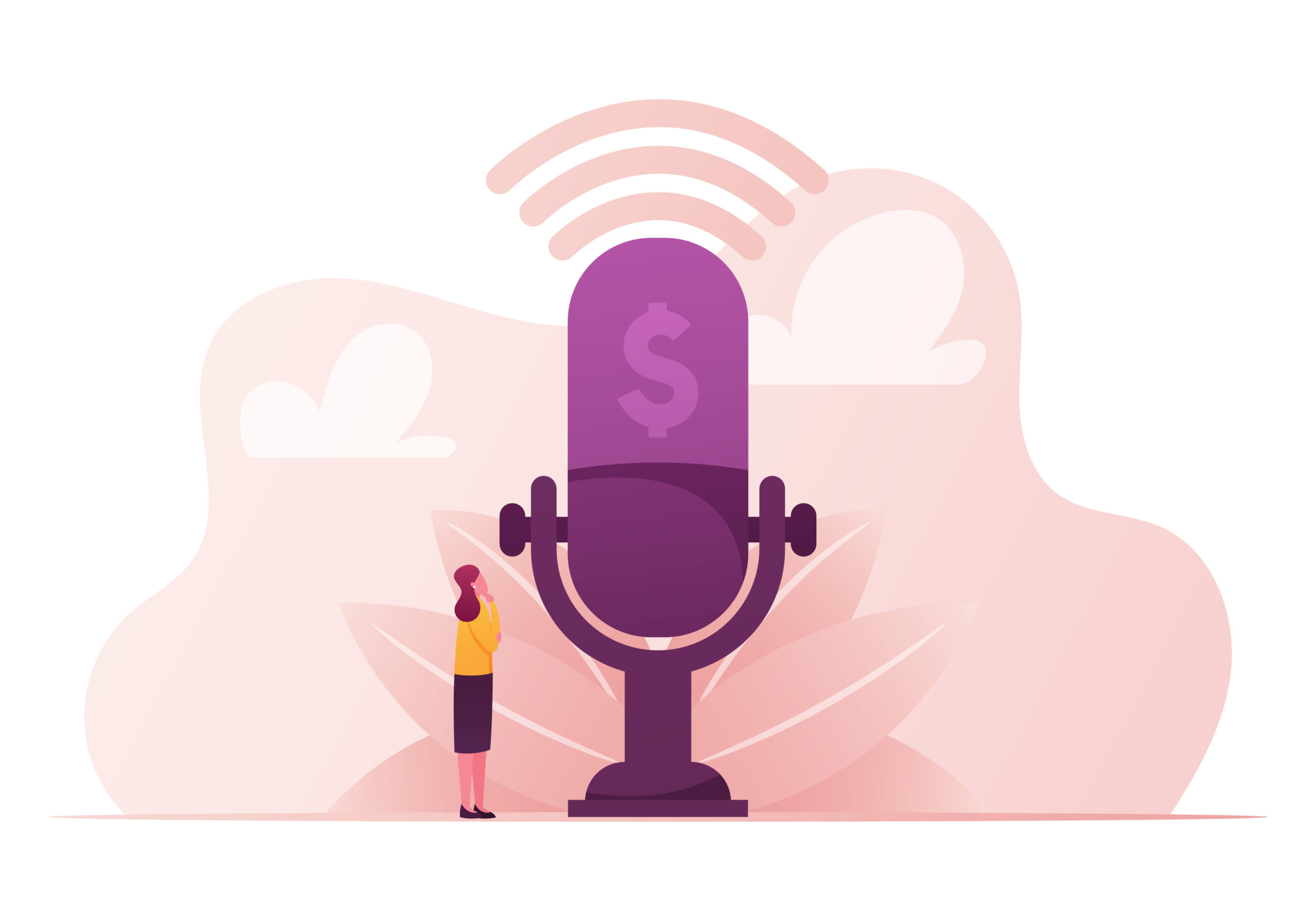 The fact public radio continues to rely on the generosity of its audience in the form of the shop-worn “pledge drives” says it all. Even the most staunchly loyal public radio devotees tune out during these exercises in begging for dollars.
The fact public radio continues to rely on the generosity of its audience in the form of the shop-worn “pledge drives” says it all. Even the most staunchly loyal public radio devotees tune out during these exercises in begging for dollars.
Public radio people are smart – they understand value proposition. In fact, many would love to hear a DIFFERENT value prop than having to sit through “begathons” multiple times each year.
Public radio listeners – as well as commercial radio listeners – will pay for content, especially podcasts. If they’re worth it.
We’ll take up that topic tomorrow, and we’ll look at some innovative ways another smart, content-rich brand is inspiring consumers to pay as they go. And do so gladly.
One thing is for sure, whether we’re talking about public, Christian, or commercial radio:
It takes just as much creativity to generate revenue as it does to create great content.
Kind Hearted Designs is a wonderful store on Etsy that you might want to check out. They designed the coffee fund jar at the top of today’s post. You can scan their gifts here.
PRPD’s virtual conference, “Let’s Go Live,” is next week. I’ll be presenting an executive summary of Public Radio Techsurvey 2020. The schedule is fantastic. Information and registration is here.
- Like A Pair Of Old Jeans - April 2, 2025
- What’s Fair Is Fair - April 1, 2025
- What’s On Your Bucket List? - March 31, 2025




Fred,
This is incredibly insightful. While I still make my living in mainstream radio, and I too tune out during “Begathons,” I will contribute on the regular to NPR because “This American Life,” Wait, Wait don’t tell me;” and scores of other compelling content; pretty much anything I need for news is there first thing, and is accessible by saying “Alexa..”(Or Siri,) “NPR headlines…” Bang, I’m up to date over coffee and can hit the studio, amped and informed. I may take in local radio later on, but for info, I did not have to sit through an island of spots to get there. NPR on demand, is uber user friendly, the way they pioneered it to be. BTW, stations need to look at their spots. They’ll need to be done better to keep people on terrestrial. But that’s a whole ‘nother blog now isn’t it, my guru friend?
Ed, much appreciated. Thanks for connecting & for the kind words.
Public Radio produces excellent content but needs more agility, especially now.
We all do, but you’re spot on, Clark.
It always comes back to great content, imagine that!
Hard to believe. But even with great content, you need to figure out how to monetize it.
I think the proverbial 50 cents for a cup of coffee analogy makes public radio seem like we’re puny, inconsequential and non-essential. After all, you may love a good cup of coffee but you can certainly survive without it. However, democracy dies in the absence of a free press, one that is untainted and not driven by corporate interests. I wouldn’t be working in this business if it was the media equivalent of a 50 cent cup of coffee, but that’s just me.
Public media’s business model is far more sophisticated than just on-air “begathons”. Most stations get about 50% of their revenue from individual contributions and only about 40% of that comes from on-air drives. We are nonprofits, after all, and we fundraise just like any other nonprofit does. It just so happens that we have broadcast towers, an asset that every other nonprofit wished they had. Even arts nonprofits that have ticket revenue and subscription services wished they could fundraise like public radio.
Our membership model is more like Patreon than it is Netflix or Spotify. Its the original crowdfunding experiment that Kickstarter and GoFundMe have taken up. Folks donate a little money to help a project come to fruition and they get a little perk for their patronage. People aren’t necessarily paying for the content, although that is why public radio is personally important to them. They are making donations to ensure that public radio is available to all Americans, especially at a time when the president is referring to all news media as the “enemy of the people”.
Abby, thoughtful as always. Thanks for your 2 cents (or 50 cents) on this thorny issue. I am a strong believer in the quality of public radio content and its mission. I want to see the system get its fair share. And as we’ve learned over the years – and especially in 2020 – it’s not enough just to create great content. We need to work harder to get our audience to value it – above ad beyond their listenership. Thanks for getting the ball rolling on this one.
Fred and Abby, AMEN! My question is whether public radio listeners would ante up if that got them a signal uninterrupted by pledge drives–the “conditional access” technology I mentioned a few weeks ago. SiriusXM mastered it, now it’s NPR’s turn to rise to the challenge. I think if even one receiver manufacturer joined the effort, they’d sell radios like hotcakes.
John, it’s all on the table. Thanks for chiming in on this one. And I hope you enjoy tomorrow’s post.
Thanks Fred. I appreciate that you and Paul were among the earliest “commercial radio folks” to immerse in public radio both as colleagues with us, and as venders, experts, partners. Analogies aside, you’re spot on with the assertion of % of users paying. We absolutely know that if we put up a paywall to our digital content we could change the business model, and be more efficient. The challenge as you point out is to be able to keep the mission orientation, AND successfully raise revenue. One good thing is that the 3 legged stool of membership, underwriting, and foundation support gives public radio a bit of risk diversity. Government support depending on the institution is hovering around 10%, so while important, is not the elephant in the room. As I used to say in my commercial radio years, “it’s about local content”, and while that ebbs and flows, I believe it’s still the critical thing.
You’re on the money (no pun intended), Tim. The system has exceptional content – locally and nationally. More creativity and even risk-taking in the “monetization” department would be most welcome.
Yes, no one loves pledge drives.
At many stations they actually still work though, especially to bring in new first-time contributors. If not, no station would do them.
And every public station would love for a higher overall percentage of listeners to contribute. But the whole point of public media is to give it away to anyone who wants it, not to sell it those who can afford it.
Listener donations aren’t really a problem right now – even with the pandemic, donation levels at many public media outlets are holding steady.
The financial problems some public media outlets are having now (layoffs, etc) seem more likely a result of years of staffing expansions built on increased underwriting (advertising sales) levels that are suddenly unsustainable in 2020.
“But the whole point of public media is to give it away to anyone who wants it, not to sell it those who can afford it.”. Yes yes yes, all day long. However, by continuing to program to an affluent white audience, isn’t public radio basically doing just that – making programming aimed at a target audience who we believe will be able to support us financially?
Abby – I agree that public radio should not be targeting “an affluent white audience,” but many seem to have, in effect, done just that.
Public radio jazz stations, like mine, are fewer in numbers than we once were, but the fact is jazz stations do generally have a more diverse listenership than news/talk, classical or AAA stations.
There’s a case to be made that the jazz has been largely gentrified out of the public radio neighborhood over the last couple decades as public radio left a more diverse group of listeners behind in order to chase growth by targeting the lucrative pool of revenue you cite.
Dan, I totally embrace the free access for all premise, but as it pertains to podcasts and other non-broadcast content, perhaps there a middle ground. I’ll be discussing some of those options in tomorrow’s post. Thanks for chiming in.
I’ve long championed NPR, including the many years I worked in commercial rock radio. After being RIFd in 2009, I spent a short period as a part time reporter for Buffalo’s legacy local affiliate 88-7 WBFO, before going back into commercial radio. I’m pleased to be a member of our local NPR affiliate in large measure because I appreciate the work and effort required to produce local content, and the superb product that originates from NPR.
Appreciate that, Jim. I know a lot of commercial radio people admire what’s being done on the public side of the airwaves.
From up here on Cloud 9, I see a paradox in perception. I hear a lot of chatter about moving into/over to podcasts, catering to younger audience, all predicated on some kind of death knell echoing in our heads, ie. Newpapers/TV/Radio/OTA is dead….etc. Public radio is not immune to the hype going around in spite of decades of evidence that listeners grow into it, and then become significant and material supporters. There is room for quality podcasts. A lot of people like them. But more people are adding media instead of outright dumping the old stuff, except for newspapers. Evolution in tastes happens over time and habits even more so. Last I heard radio’s penetration was still in the neighborhood of 92 percent and more people are listening more at home since the pandemic hit. While there is no doubt there is evolution, we should all remember that radio has no login, no paywall, no tracking cookies, no opt in/opt out of spam emails, no data consumption (OTA), need I go on? A podcast is an occasional thing. The broadcast goes on now matter how you get it. I prefer OTA owing to the neat clean ease of turning on a receiver. I’ll do me. We can all do a better job of telling our story, telling good stories, and generating the revenue needed to support it. I’m holding a tab open for your next post. Bon chance!
Oh jeez. It’s embarrasing. I’m commenting on my comment….. As far as evolution goes, the original Ipod generation got tired of spending a bunch of time managing their media when they grew up. They developed a tendency to adopt media habits more like their elders. Maybe we should find out if that is still a thing. And as for money, the grownups and their parents have most of it. When you make content, remember to make some for the people who have money. .02USD
Or “fish where the fish are.
Uncle Lalo, thanks for this. I believe there’s a distinction between podcasts and broadcasts, especially how they’re nominated. And while some new media is “additive” to broadcast, there are growing indicators that podcasts are, in fact, erosive to over the air listening. COVID has also exposed the bind that many broadcast stations find themselves in when so many are no longer spending lots of time in cars. Good viewpoints here, that I’m sure will generate response.
Public Radio has some of the best content out there and as a non-profit, they have put money back into the product for things that Commercial Radio hasn’t in terms of streaming, podcasting, digital, websites and people.
Their issue now though monetizing what they have.
Instead of castigating listeners for not “contributing”, they should take a cue from their Commercial brethren and do a better job of selling that content to advertisers.
Of course they would have to change their mindset and go out and compete for business like everyone else in the world instead of hoping simpatico business find them but they have great content, passionate listeners and an uncluttered environment. What is there not to like?
Things aren’t going to get easier for them or for commercial radio and if you aren’t ready to fight for dollars – not just from the government or the listeners – you aren’t going to be around for long.
Thanks, Mike. Certainly, more time, effort, and creativity will need to go into monetization of this content. Appreciate the comment.
Good forum Fred. I’m late to it. Most of what I wanted to say was said by Abby Goldstein. Public radio is “like a charity” because we are a charity. Non-profit organizations meant to be working for the broader public good, providing good and sometimes great content for undeserved audiences and under-heard points of view. It’s supposed to be a struggle to some degree because most charitable work is.
It WOULD be less of a struggle if it wasn’t close to the bottom of what is asked of the public to support it through its government…a pittance compared to most every developed nation in the world.
But it’s remarkable how public radio has creatively pieced together the multiple income streams over the years through good economic times and bad. Many of those outlets are relearning the importance of local, (that commercial radio generally dropped the ball on). And yes, pub radio has done generally well on adopting to the newer platforms. Good on us.
And BTW, “quieter” fund drives appear to work as well as “begathons” as long as pubcasters put more thought into having their best, authentic communicators delivering the messages…instead of reading dry scripts. Fund drive content CAN be worthwhile listening! Shorter, sweet, thoughtful, funny, moving. We just have to work it creatively people.
Subscriptions? Maybe for some value-added content but I’d hesitate about moving toward exclusive club tiers. The mission really IS about universal access for the common good.
If you’re not up for the struggle of doing non-profit public media work… on a shoestring with shoestring budgets sometimes… go do something else with your creative energy.
Well said, Paul. I hope my comments aren’t construed as being out-of-sync with public radio’s values or its mission. I agree how the system is managed to cobble together new revenue streams – always with strong quality. I concur that local is becoming more off a priority, but I am concerned that once we get beyond the biggest markets, many stations in medium and small metros are on thin ice.
You ended up in the same area code I did. Perhaps subscriptions make sense for premium, added-value content. However it happens, I think it’s an idea worth pursuing. Thanks for adding to the conversation.